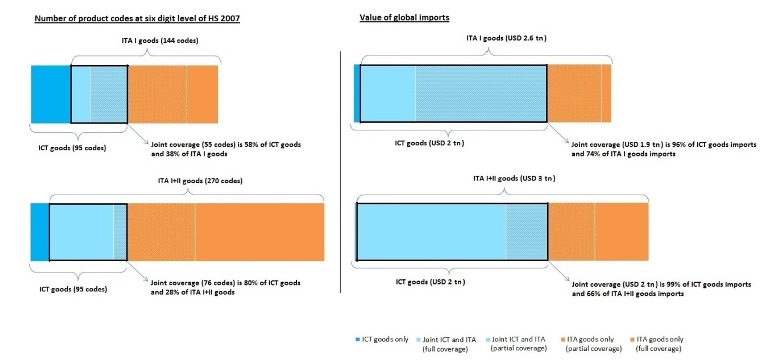New UNCTAD research shows that the expansion of the list of technology goods earmarked for duty-free treatment by participating economies of the World Trade Organization's Information Technology Agreement (ITA), agreed to in July 2015, will cover 99 per cent of the value of global information and communications technology (ICT) goods, and some 80 per cent of all product lines in this category1.
The research, published in a technical note, Trade in ICT Goods and the 2015 Expansion of the WTO Information Technology Agreement, on 15 December 2015, also indicates that the expanded list covers many goods that were not classified as ICT products under the original agreement such as medical appliances, electric conductors and instruments.
"This amendment is relevant to the use of information and communications technology for development because ICT goods generate a multitude of social and economic benefits, as shown in UNCTAD's Information Economy Reports," UNCTAD Deputy Secretary-General Joakim Reiter said. "Making ICTs more affordable, for example, by lowering import duties, can lead to higher adoption rates and increasingly complex applications. Beyond the ICT sector itself, ICTs can be used to boost the competitiveness of other sectors, such as automotive and business services, which have ICT goods as intermediate inputs, and enable participation in global value chains."
Equivalent to a market worth more than $3 trillion, goods included in the original ITA of 1996 (ITA I) and in the revised ITA list of 2015 (ITA II) represent almost one fifth (18 per cent) of world merchandise imports.
The expanded agreement currently has 54 participants, which in 2013 accounted for 87 per cent of world imports and 94 per cent of world exports of ITC goods. Once it comes into force, exports from all of the WTO's 162 members – irrespective of whether they were signatories – will enjoy duty-free treatment of the listed goods in markets covered by the ITA II. These include new-generation semi-conductors, GPS navigation systems, medical products which include magnetic resonance imaging machines, machine tools for manufacturing printed circuits, telecommunications satellites and touch screens.
The main findings of the research reveal that:
• The expansion of the product coverage of ITA II will mean that almost all ICT goods traded will receive duty-free treatment when imported into ITA II member economies. The ITA I+II product list encompasses more than 99 per cent of the value of global ICT goods imports (see chart, right-hand side) and 80 per cent of the ICT goods product lines.
• In value terms, ICT goods account for two-thirds of all imports of ITA I+II goods (see chart, right-hand side). At the same time, the expanded ITA II increases the product coverage also for other, non-ICT goods, such as medical appliances, electric conductors and instruments. Indeed, ICT goods make up just over a quarter of the individually-identified product lines covered by ITA I+II (see chart, left-hand side).
• Although the list of products covered by the new list has expanded, fewer WTO members are party to ITA II than ITA I. While far from all developing and transition member economies of the WTO had signed up to ITA I (in total 81 WTO Members are contracting parties to ITA I), even fewer have so far joined the ITA II – just one African country (Mauritius), and three in Latin America (Colombia, Costa Rica and Guatemala) and none from the Commonwealth of Independent States. Developing Asian countries are better represented, but there remain fewer parties from this category to ITA II than there were to ITA I.
• That being said, the largest exporters and importers of both ICT goods and ITA I+II goods are signatories of both ITA I and II. Mexico is the only non-ITA II member among the top 10 traders of such products. Other non-ITA II members with exports of ITA I+II goods, of above $10 billion annually, are Viet Nam and India. On the import side, non-ITA II members with the 10 highest related imports are Mexico, India, the Russian Federation, Viet Nam, Brazil, Indonesia, Saudi Arabia, South Africa, Argentina and Chile. Consumers in these economies will not benefit from the duty-free provisions of ITA II after it goes into force.
Chart: Comparison of ICT goods with goods covered by ITA I and ITA I+II: number of Harmonized System product codes (left panel) and value of global imports (right panel)
Note: HS stands for Harmonized System, an international nomenclature for the classification of products. At the international level, the Harmonized System (HS) for classifying goods is a six-digit code system. ITA I was based on a list of products defined in HS1996, with some product codes only partially covered. The ITA I goods in this figure include all the unique six-digit HS2007 product codes in the HS2007 ITA I model list, as per WT/L/956 and JOB(07)/96, including partially covered products. The global trade figures include re-imports.
Source: UNCTAD based on UN COMTRADE data.
Press Release
For use of information media - Not an official record
UNCTAD/PRESS/PR/2015/049 Expanded list of duty-free technology products to boost international trade and development, research reveals
Geneva, Switzerland, 15 December 2015



